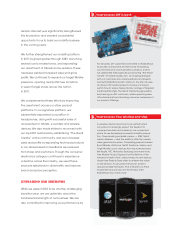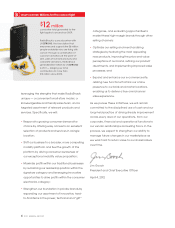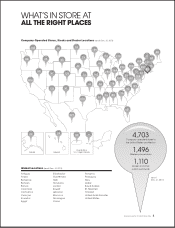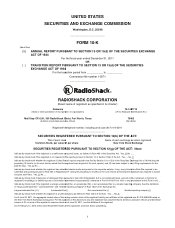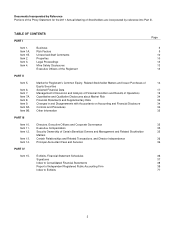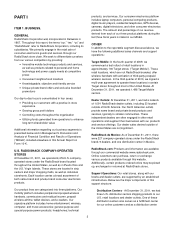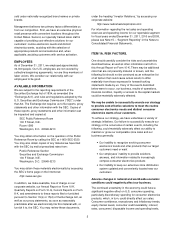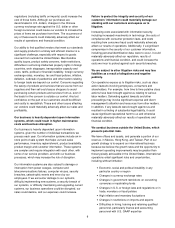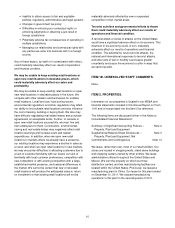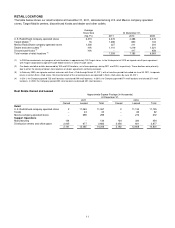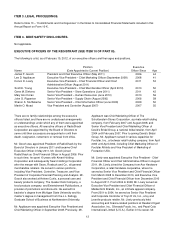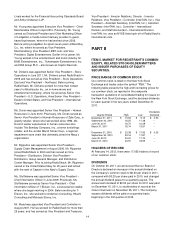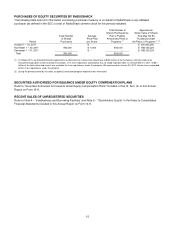Radio Shack 2011 Annual Report Download - page 15
Download and view the complete annual report
Please find page 15 of the 2011 Radio Shack annual report below. You can navigate through the pages in the report by either clicking on the pages listed below, or by using the keyword search tool below to find specific information within the annual report.7
from our competitors could require us to reduce prices or
increase our costs in one product category or across all our
product categories.
Our competitors may use strategies such as lower pricing,
value-added services, wider selection of products, larger
store size, higher advertising intensity, improved store
design, and more efficient sales methods. Some of our
competitors may be able to offer innovative, technologically
superior, or more desirable products and services that are
not available to us, are available in limited quantities, or
become available to us after the demand for the products
and services has declined. While we attempt to differentiate
ourselves from our competitors by focusing on the
electronics specialty retail market, our business model may
not enable us to compete successfully against existing and
future competitors. As a result of this competition, we may
experience lower sales, margins or profitability, which could
materially adversely affect our results of operations and
financial condition.
We are dependent upon our relationships with a limited
number of name brand product and service providers,
and our inability to create, maintain and renew
relationships with these parties on favorable terms
could materially adversely affect our results of
operations and financial condition.
A significant portion of our net sales and operating
revenues is attributable to a limited number of name brand
products and service providers. The concentration of
revenue in our mobility platform means that our revenue is
to a significant degree dependent upon a limited number of
service providers such as AT&T, Sprint, and Verizon and
related product suppliers such as Apple, HTC and
Samsung. In the aggregate, these relationships have or are
expected to have a significant effect on both our operations
and financial strategy. If we are unable to create, maintain
or renew our relationships with such third parties on
favorable terms or at all, or if these third parties limit or
disrupt the supply of their products or services to us, our
results of operations and financial condition could be
materially adversely affected.
Certain of our wireless service providers make operational
changes from time to time that adversely affect our
business and over which we have little, if any, influence.
They may not inform us of such a change or may do so
only after it is too late for us to adequately predict and plan
for the consequences the change will have on our
business. The information they provide to us about these
changes may be incomplete or inaccurate. Examples of
these changes include changes to customer credit
requirements, changes to the service providers’ service
agreements with their customers on issues such as
handset upgrade eligibility and contract renewal terms, and
other changes that affect our mobility business. If we are
not timely, accurately, and adequately informed about these
changes or are unable to effectively mitigate the adverse
impact of these changes on our business, these changes
could materially adversely affect our results of operation
and financial condition.
Our inability to increase or maintain our gross margin
levels could materially adversely affect our results of
operations and financial condition.
We may not be able to increase or maintain our gross
margin levels due to various factors, including increased
sales of lower margin products or declines in average
selling prices of key products. If sales of lower margin items
continue to become a larger percentage of our business
without an overall growth in our sales, our gross profit could
be materially adversely affected.
Our inability to collect receivables from our vendors
and service providers could materially adversely affect
our results of operations and financial condition.
We maintain significant receivable balances from various
vendors and service providers such as Sprint, AT&T,
Verizon, and T-Mobile consisting of commissions and other
funds related to these relationships. At December 31, 2011
and 2010, our net receivables from vendors and service
providers were $273.8 million and $291.0 million,
respectively. The average payment term for these
receivable balances is approximately 45 days. We do not
factor these receivables. Changes in the financial condition
of one or more of these vendors or service providers could
cause a delay or failure in collecting these receivable
balances. A significant delay or failure in collecting these
receivable balances could materially adversely affect our
results of operations and financial condition.
Our inability to manage our inventory levels effectively,
particularly excess or inadequate amounts of
inventory, could materially adversely affect our results
of operations and financial condition.
We source inventory both domestically and internationally,
and our inventory levels are subject to a number of factors,
some of which are beyond our control. These factors,
including technology advancements, vendor-imposed
quantity purchasing requirements, reduced consumer
spending and consumer disinterest in our product offerings,
could lead to excess inventory levels. Additionally, we may
not accurately assess product life cycles, leaving us with
excess inventory. To reduce this excess inventory, we may
be required to lower our prices, which could materially
adversely affect our results of operations and financial
condition.
Alternatively, we may have inadequate inventory levels for
particular items, including popular merchandise, due to
factors such as unanticipated high demand for certain


